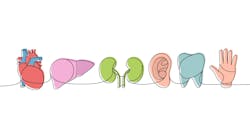Listen to the article on our podcast!
Editor's note: This is part one of a two-part series. Read part two.
I thought I knew about comorbidities. It is one of those words that is used more in the media and medical writings, but not so much in conversation with common society. Although it seems like the word comorbidity has been used more in recent years, it is not an everyday term, especially not in dentistry.
I presumed the definition of a comorbidity was a severe case of having more than one fatal disease (or one that can lead to a fatality), or a condition that altered, affected, or worsened the body or current diseases within. But that is not the case. Comorbidities are the coexisting of unhealthy conditions—nothing about the severity or mortality of a disease. A comorbidity occurs when two or more medical conditions coexist alongside a primary diagnosis or diseases within a person at the same time. They can occur separately or as a result of one another and may interact or alter the course of a medical condition.1,2
This begs the question: Can oral health be a comorbidity? I have searched how periodontal disease could be considered in the realm of health issues, beyond what we know with oral and systemic risks. The oral cavity is second, behind the gastrointestinal system, in having the largest microbiota of bacterial species.3 The overall health of the mouth is a crucial factor, whether there is active disease or not, and is worth taking into consideration for the bigger picture.
Let’s consider bruxism, erosion, cracked tooth syndrome, oral cancer, thrush, TMJ disorders, airway resistance, xerostomia, dental caries, tooth abscess, pulpitis, mouth sores, medication side effects, and the use of alcohol, cigarettes, and drugs—all of these are symptoms or the cause of a bigger picture. In and of themselves they can be influential or an indication toward comorbidities. As research shows, periodontal disease and even rampant decay can increase systemic risks, but my focus will be on periodontal disease.
While periodontal disease can easily stand alone as a morbidity (one disease), it is also linked as part of the multiple systemic diseases to be rightfully considered a comorbidity (two or more diseases together). So, should or could we use this word as a device when talking about periodontal disease to patients? Could we use it beyond explaining to the patient about their periodontal health and the pathogenic bacteria that not only can cause gum and bone damage resulting in tooth loss, but can also cause negative results in vulnerable parts of the body?
If a patient heard “you have the (co)morbidity of periodontal disease” versus “you have periodontal disease,” it might get their attention and interest and even motivate them to improve their oral health.
Oral health conditions can easily be considered a comorbidity. Should we take an innovative approach in classifying periodontal disease as a comorbidity? Let’s take a closer look at the morbidity realm. While comorbidity has been defined above, there are other terms to consider.
Morbidity: This is the state of having a specific disease or medical condition, either mental or physical. When the condition worsens, it not only affects a person’s health but also their quality of life.4
Multimorbidity: According to the U.S. Department of Health and Human Services, multimorbidity is defined as having at least two chronic medical diseases, each of which lasts more than a year. This classification increases poor quality of life and the likelihood of dying prematurely.2
Mortality: This is another term for death, and many comorbidities are at a higher risk for mortality. In my experience, many patients have at least two comorbidities.
(Co)(multi)morbidities: These are defined with the words disease and condition, according to The Free Dictionary:
Disease: An abnormal condition of a part, organ, or system of an organism resulting from various causes, such as infection, inflammation, environmental factors, or genetic defect, and characterized by an identifiable group of signs, symptoms, or both.5
Medical condition: A disease, illness, or injury; any physiologic, mental, or psychological condition or disorder; a state of health, physical fitness, or ailment.6
Periodontal disease
Periodontal disease (as the word disease was mentioned in the definition of the morbidities family) is a set of inflammatory conditions that affect the soft and hard tissues around the teeth. It is a multifactorial disease depending on the host response, lifestyle, habits, genetics, medical systemic risks, overall oral health, and infection and immune response. Periodontal disease is the broader name for gum disease, ranging from gingivitis to severe periodontitis, acute to chronic, aggressive to slow-acting (over time), active to stable, plaque and nonplaque induced, localized and generalized.
Periodontal disease is considered the sixth most prevalent disease worldwide.7 Within the definition of a comorbidity is the verbiage “disease from various causes, specifically inflammatory, infection, and environmental and lifestyle response.” Periodontal disease commonly emerges through an inflammatory response, by way of a steady population of bacteria, to trigger the immune system. Cytokines and pro-inflammatory mediators are released in the inflammatory process to create bone and tissue loss. Not only is periodontal disease a low-grade infection, but it also contains pathogenic bacteria that release into the body via swallowing, inhaling, and permeation through infected pockets. As such, it can compromise already susceptible areas of the body and other comorbidities.8
Periodontal disease, on its own, is easily a morbidity. As research has expanded, associating this disease with many comorbidity diseases seems to have, unfortunately, earned its place in this group of medical diseases. Periodontal disease requires treatment to help resolve the infection and then needs to be maintained for life as once the disease is there, it is a continual risk—like a heart attack survivor will always be a heart patient.
A comorbidity may occur through1,2
- The interrelation of organ systems
- The infection route follows the same path, and periodontal disease shares inflammatory mechanisms with many comorbidities.
- Multiple organ systems affected
- Chance occurrence between two conditions
- Overlapping risk factors
- One condition resulting from complications of the other
- A third condition causing both conditions
Why periodontal disease should be classified as a comorbidity
Keep in mind that a periodontal pocket covers a surface of 8–20 cm2 (800–2,000 square cm to mm or 1–3 square inches),9 and more than 200 microbial species are involved in apical periodontitis and more than 500 microbial species reside in marginal periodontitis.10
Not only is perio disease a host of local complications of:
- Tooth and bone loss
- Gingival recession
- Abscesses
- Halitosis
- Pain
- Acute/chronic infection
- Tooth migration
- Mobility
… but it also can increase systemic complications.
According to a recent study, the 10 most prevalent and costly chronic diseases are obesity, hypertension, high cholesterol, coronary heart disease, chronic obstructive pulmonary disease, asthma, chronic kidney disease, diabetes, cancer, and depression.11 This enhances the case for periodontal disease being a comorbidity as it is linked to all 10 of these chronic diseases. More will be discussed in part two.
Editor's note: This article appeared in the April/May 2025 print edition of RDH magazine. Dental hygienists in North America are eligible for a complimentary print subscription. Sign up here.
References
- Yetman D. Comorbidity: causes and health implications. What is comorbidity? Healthline. April 4, 2022. https://www.healthline.com/health/comorbidity#definition
- Comorbidities. Cleveland Clinic. March 15, 2024. https://my.clevelandclinic.org/health/articles/comorbidities
- Deo PN, Deshmukh R. Oral microbiome: unveiling the fundamentals. J Oral Maxillofac Pathol. 2019;23(1):122-128. doi:10.4103/jomfp.JOMFP_304_18
- Basaraba S. Morbidity vs mortality: what’s the difference? Verywell Health. May 1, 2023. https://www.verywellhealth.com/what-is-morbidity-2223380
- Definition of disease. The Free Dictionary. https://medical-dictionary.thefreedictionary.com/disease
- Definition of condition. The Free Dictionary. https://medical-dictionary.thefreedictionary.com/condition
- Larvin H, Kang J, Aggarwal VR, Pavitt S, Wu J. The additive effect of periodontitis with hypertension on risk of systemic disease and mortality. J Periodontol. 2022;93(7):1024-1035. doi:10.1002/JPER.21-0621
- Martínez-García M, Hernández-Lemus E. Periodontal inflammation and systemic diseases: an overview. Front Physiol. 2021;12:709438. doi:10.3389/fphys.2021.709438
- Hajishengallis G, Chavakis T. Local and systemic mechanisms linking periodontal disease and inflammatory comorbidities. Nat Rev Immunol. 2021;21(7):426-440. doi:10.1038/s41577-020-00488-6
- Li X, Kolltveit KM, Tronstad L, Olsen I. Systemic diseases caused by oral infection. Clin Microbiol Rev. 2000;13(4):547-558. doi:10.1128/CMR.13.4.547
- Benavidez GA, Zahnd WE, Hung P, Eberth JM. Chronic disease prevalence in the US: sociodemographic and geographic variations by zip code tabulation area. Prev Chronic Dis. 2024;21:E14. doi:10.5888/pcd21.230267









